|
 Weraroa virescens Weraroa virescens
SynonymsSecotium virescens
Secotium superbum
BiostatusPresent in region - Indigenous. Endemic
Images (click to enlarge)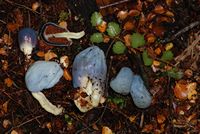
Owner: J.A. Cooper | 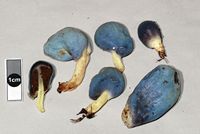
Owner: J.A. Cooper | 
Caption: Weraroa virescens
Owner: Kaimai Bush | 
Caption: Weraroa virescens
Owner: Kaimai Bush | 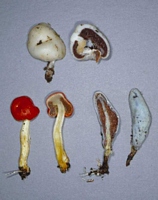
Caption: Weraroa novaezelandiae (top), W. erythrocephala (left), and W. virescens (right).
Owner: R.E. Beever | 
Owner: Herb. PDD | 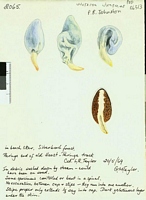
Caption: Watercolour
Owner: G.M. Taylor | 
Caption: Weraroa virescens: 7511: see photo, bright blue with brown gleba
Owner: Greg Mueller | 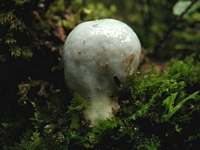
Caption: FUNNZ photo
Owner: J.A. Cooper | 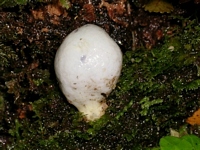
Caption: FUNNZ photo
Owner: J.A. Cooper | 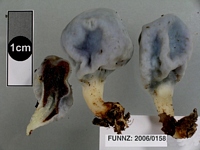
Caption: Col. DAO 2085, FUNNZ: 2006/0158, See public note for more information
Owner: FUNNZ | 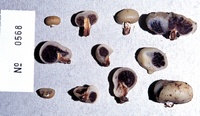
Caption: ZT0568
Owner: E. Horak: © Creative Commons Attribution-Noncommercial 3.0 New Zealand | 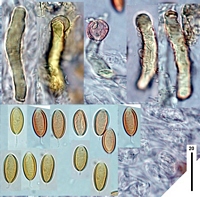
Caption: top: chryso pilocystidia, and spores
Owner: J.A. Cooper |
Article: Cooke, M.C. (1890). Fungi of New Zealand. Grevillea 19(90): 47-49.
Description: Peridium ovate, apex acute, basal portion at first attached to the stem, becoming free and
expanding, wall coriaceous, even, smooth and shining, pale green ; stem below basal
attachment of peridium short, incrassated, tapering upwards, solid, smooth and even,
yellowish at the base; gleba bright ferruginous orange, cavities small, sub-equal and
regular, septa thin ; basidia large, clavate tetrasporous, sterigmata slender, elongated ;
spores elliptic-oblong, smooth, bright rusty-orange, 18-20 x 7-8 µ.
Notes: Peridium 3 x 2 c.m., stem below basal margin of peridium, -5 c.m. long.
Resembling S. acuminatum in shape, but smaller, and differing in colour, polished
peridium, and more especially in the spores. A portion of the type specimen of A.
acuminatus sent by Montagne to Berkeley has pale olive, broadly elliptical spores
measuring 5-6 x 4 µ.
Article: Cunningham, G.H. (1924). A critical revision of the Australian and New Zealand species of the genus Secotium. Proceedings of the Linnean Society of New South Wales 49(2): 97-119.
Description: Peridium pallid sage-green, ovate or broadly conical, apex obtusely acuminate, base abruptly
rounded, slightly or not excavated, 2-3 cm. high, 2-2.5 cm. broad, coriaceous, glabrous,
shining, with occasional longitudinal furrows, margin lacerate, somewhat decurrent; drying
dull green. Stipe greyish-white, short (almost obsolete in the specimen examined), about 5
mm. long, hollow, smooth, glabrous, tapering from base to apex; columella slightly expanded
at the apex. Gleba ferruginous, cellular, cells regular, laterally compressed, 2-3 mm. long,
dissepiments thin, enclosed within a dense purplish-brown layer within the wall of the
peridium. Spores smooth, pallid ferruginous, elliptical, ends bluntly pointed, 15-18 -x 7-8 µ
(Massee 18-20 x 7-8 µ; Cleland 14.5-16 x 8 µ), epispore thin.
Habitat: Habitat.-Solitary on the ground in rain forest.
Notes: This species is characterised by the colour of the peridium and gleba, short, almost obsolete
stipe and the large size of the spores. The plant somewhat resembles the preceding [Secotium
superbum]
I am indebted to Dr. Cleland for the loan of the specimen from which the above description
has been drawn up. In a note accompanying the specimen he fias given details as to the
colour, shape and size of the peridium when collected, and these have been incorporated in
the above description.
This species was originally described from material forwarded to Kew by Colenso. It is
apparently rare, for, with the exception of one collection made by the late Mr. T. Kirk, Dr.
Cleland's plant is the only collection made since the species was described.
Article: Cunningham, G.H. (1924). A critical revision of the Australian and New Zealand species of the genus Secotium. Proceedings of the Linnean Society of New South Wales 49(2): 97-119.
Description: Peridium azure, sage-green or sea-green, sometimes mottled with pallid spots, conical, apex
sharply acuminate, base strongly excavated, truncate, or more frequently margin decurrent, up
to 8 cm. high, and 4 cm. wide, at first pruinose, becoming glabrous, polished and slightly
viscid; drying dull green or olivaceous. Stipe bright yellow, stout, up to 5 cm. long, and 12
nnm. wide, tapering from base to apex, smooth, shining, hollow; columella slightly thickened
at the apex. Gleba ferruginous, cellular, cells 2-4 mm. long, laterally compressed,
dissepiments thin. Spores smooth, pallid ferruginous, ovate or elliptical, one end rounded, the
other pointed, frequently shortly pedicellate, 14-18 x 6-8 µ, epispore thin.
Habitat: Habitat.-Solitary on the ground in grassy places in the forest.
Notes: The large conical peridium, stout yellow stipe and large smooth spores characterise this
species. It closely resembles the following species [Secotium columella], but is separated on
account of the shape and large size of the peridium It is a magnificent species, the azure
peridium and yellow stipe being very conspicuous. The base of the peridium does not as a
rule separate from the stipe, but remains closely pressed to it. This is one of the largest
species known, and should be readily determined on this account.
|